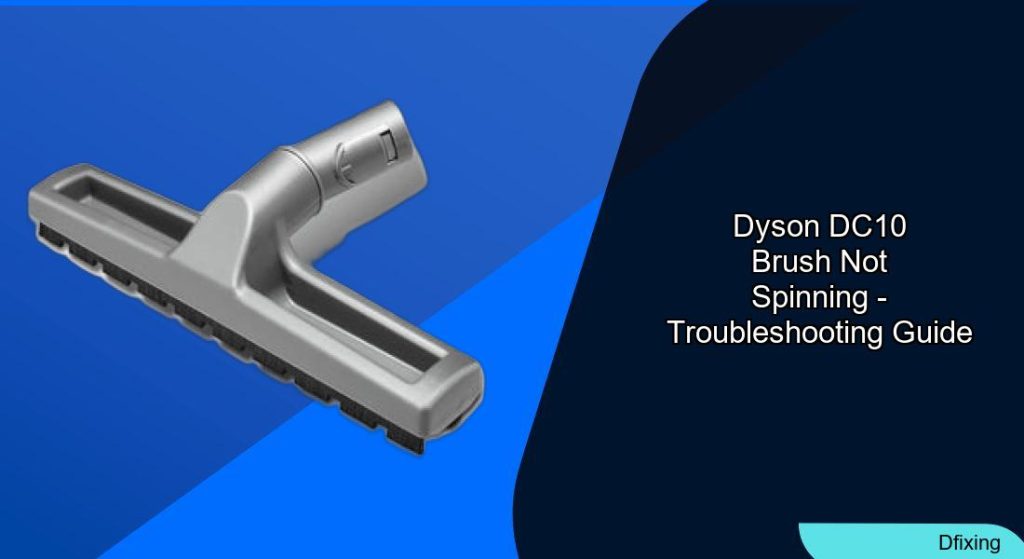A malfunctioning brush bar on your Dyson DC10 can turn a simple cleaning task into a frustrating ordeal. When the brush fails to spin, dirt and debris linger, reducing your vacuum’s effectiveness. This guide dives into the root causes of this issue and provides clear, actionable steps to restore your vacuum’s performance. Whether you’re dealing with tangled hair, electrical faults, or mechanical wear, you’ll find solutions tailored to your specific problem. From basic maintenance to advanced repairs, we’ll help you troubleshoot like a pro and keep your Dyson DC10 running smoothly.
Affiliate disclosure: As an Amazon associate, We'll earn a commission for every successful order through our affiliate links in the article. However, you won’t be charged anything for this.
The article covers everything from identifying common culprits like debris blockages and broken cables to addressing water damage, seized bearings, and electrical connection issues. You’ll also discover model-specific tips for Dyson V6/DC59, V11, and Ball variants, along with essential maintenance practices to prevent future problems. By the end, you’ll have the knowledge to tackle the issue head-on—or know when it’s time to seek professional help.
Common Causes and How to Resolve Them
Debris Blockage: The Most Likely Culprit
Hair, lint, and dirt often around the brush bar, stopping it mid-rotation. To fix this:
1. Power down and unplug the vacuum to ensure safety.
2. Open the brush roll access door by pressing the tabs on the vacuum’s base.
3. Remove the brush bar and cut away tangled debris with scissors.
4. Reinstall the brush bar securely, ensuring both ends click into place.
5. Check the access door fits snugly—if not, reseat the brush bar.
Broken Cable in the Joint
A frayed or snapped cable inside the wand-to-brush head joint can disrupt power when rotating the head. Test this by:
1. Turning on the vacuum and gently rotating the brush head.
2. Inspecting the joint for visible cable damage.
3. Replacing the cable if broken (requires basic electrical skills or a technician).
Water Damage or Cut Wires
Moisture or damaged wiring can kill the brush head’s motor. Look for:
1. Corrosion or dampness on the brush head connectors.
2. Exposed cuts in wires along the wand or head.
3. Replacing the affected component—brush head or wiring—if damage is confirmed.
Seizing Bearings
If the motor spins freely without the brush bar attached but stalls when reassembled, the bearings may be worn. Fix this by:
1. Testing the motor alone to confirm it works.
2. Inspecting bearings for stiffness or rust.
3. Replacing bearings to avoid full head replacement.
Electrical Connection Issues
Dust buildup or corroded contacts often disrupt power flow. For V6/DC59 models:
1. Clean metal prongs in the wand with rubbing alcohol and a Q-tip.
2. Disassemble the canister and scrub internal contacts.
For V7/V8/V11 models:
1. Check pins at the brush head base for debris.
2. Clean dust filter contacts by sliding out the filter and wiping connections.
Model-Specific Troubleshooting
V6/DC59: Focus on Electrical Contacts
These models frequently suffer from poor conductivity between the motor and head. Use Q-tips and rubbing alcohol to clean prongs and internal ports, ensuring a secure connection.
V11 and Ball Models: Hidden Hair Traps
Hidden compartments at the back of the head collect tightly wound hair. Remove end caps and guards with a Torx screwdriver to access and clear these areas.
Maintenance Tips to Prevent Future Issues
- Weekly: Clean electrical contacts and dust filter ports with rubbing alcohol.
- Biweekly: Remove hair from the brush bar, bearings, and hidden compartments.
- Avoid Overloading: Don’t vacuum long strands or excessive debris without first picking them up manually.
- Post-Use Inspection: Check the brush bar for obstructions after each session.
Frequently Asked Questions (FAQ)
What tools are needed to fix a non-spinning Dyson brush?
You’ll need scissors, a Torx screwdriver (T8 for V6/V7/V8), flathead screwdriver, Q-tips, rubbing alcohol, and a coin/spoon for brush bar removal.
How do I know if the brush motor is faulty?
If the motor spins freely without the brush bar attached, the issue lies elsewhere (e.g., bearings, cables). If it doesn’t spin at all, the motor may need replacement.
Are replacement parts for Dyson DC10 hard to find?
Some users report difficulty sourcing parts. Contact Dyson support, explore third-party repair kits, or check online forums for DIY solutions.
Can water damage be repaired?
Yes, but only if addressed promptly. Replace damaged wires or the brush head to restore functionality.
Conclusion
A Dyson DC10 brush that won’t spin is a common but solvable issue. By systematically addressing debris blockages, electrical faults, and mechanical wear, you can revive your vacuum’s performance. Regular maintenance—like cleaning contacts and removing hair buildup—will prolong its lifespan. For complex problems like broken cables or motor failures, consider professional help. With these steps, your Dyson DC10 will be back to its efficient self in no time.
Pro Tip: If troubleshooting fails, Dyson’s customer service or certified repair centers can provide model-specific solutions and replacement parts.







